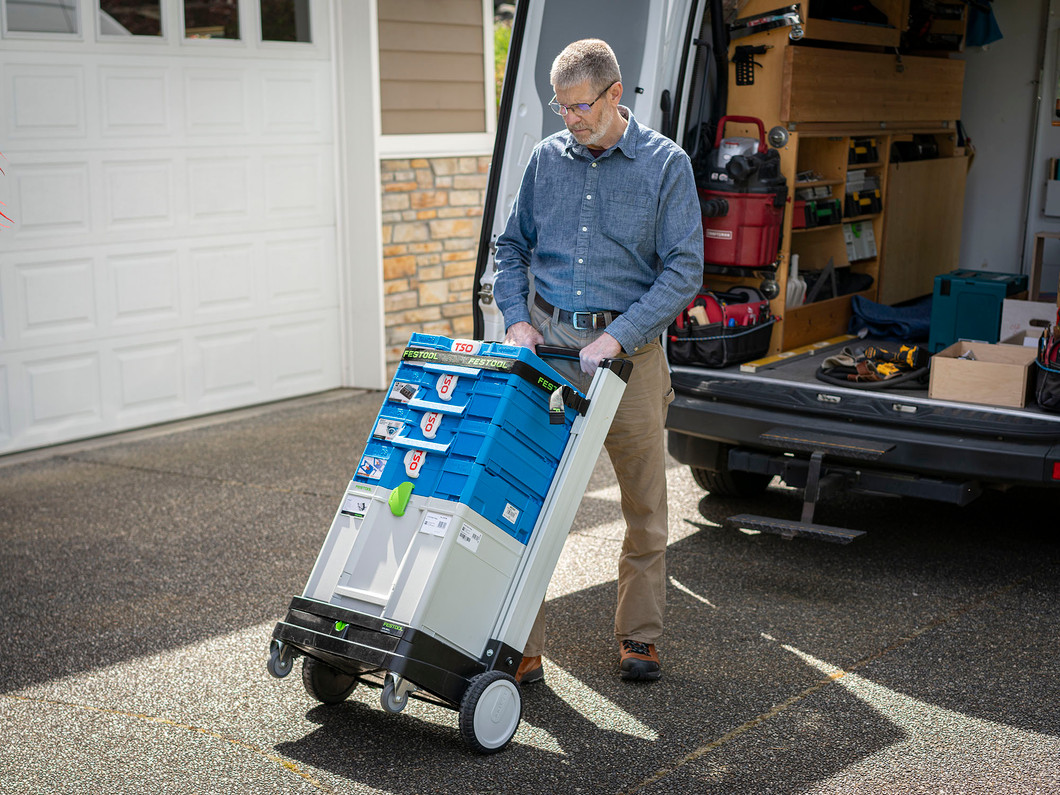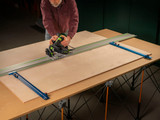Systainer Storage Guide: Organize Your Workshop Tools
Picture this: you're setting up for what should be a straightforward series of cuts, but you can't locate the specific guide rail stop you need. Twenty minutes later, after searching through three different toolboxes and moving aside piles of loose accessories, you finally find the component buried at the bottom of a drawer. Now multiply those twenty minutes by every time you've hunted for a missing accessory, small component, or specialty tool during setup. Over a year, those frustrating search sessions add up to hours of lost workshop time.
Disorganized tool storage steals your most valuable resource: time in the shop. Lost components force expensive replacements, and inefficient setups eat into profitable project hours for professionals while robbing hobbyists of precious weekend workshop time. Whether you're running a business or pursuing your craft for personal satisfaction, systematic organization directly impacts both workflow efficiency and the time you actually spend creating.
What Makes Systainer Storage Different
Unlike traditional toolboxes that become black holes for small components, the Systainer platform operates on modular principles that transform storage from necessary evil into workflow advantage. The stackable, interlocking design allows complete tool systems to travel together rather than scattering across multiple containers.
The key difference lies in systematic integration rather than random storage. Traditional toolboxes encourage throwing everything together—nuts, bolts, accessories, and precision tools jumbled into generic compartments. Systainers facilitate deliberate organization where related components stay grouped and protected throughout transport and storage–with the right insert, of course.
Key advantages over traditional storage:
- Modular connectivity - Systems travel together as unified units
- Custom tailored - Many systainers include foam or plastic inserts that keep your tools and components planted–no more loose parts rattling in truck beds
- Systematic deployment - Complete tool sets arrive ready to work
- Space efficiency - Identical footprints stack and store cleanly
Organization Strategies That Work
Tool Grouping Strategies
System-based organization groups tools by function rather than size or frequency of use. Track saw components stay together regardless of individual tool dimensions. Guide rail accessories occupy dedicated space even when some pieces see daily use while others remain standby items. Sanders stay grouped with their associated abrasives. This approach ensures complete systems deploy together when needed.
Project-based grouping works for specialized operations but can create inefficiencies when tools serve multiple project types. A parallel guide system might support both cabinet work and outdoor construction, making project-specific storage less practical than system-based organization.
Foam Insert Benefits
Custom foam inserts transform generic storage into tool-specific organization that provides multiple advantages beyond simple containment. Precision-cut compartments eliminate the rattling and shifting that damages delicate components during transport. Visual inventory becomes instant—missing tools show up as obvious gaps rather than requiring complete container searches.
Foam insert advantages:
- Tool protection - Eliminates scratches and dings from loose storage
- Visual inventory - Missing components show as obvious gaps
- Quick access - No digging through jumbled contents
- Custom layouts - Precision-cut compartments for exact tool positioning
Workflow Optimization
Reducing setup and breakdown time provides the most measurable benefit from systematic storage. Operations that previously required gathering components from multiple locations become single-container deployments. Track saw work, precision measurement, and complex assemblies start faster when all necessary tools arrive together.
Breakdown efficiency matters equally for maintaining organization long-term. When every component has a designated location, cleanup becomes automatic rather than requiring decisions about where items belong. This consistency prevents the gradual degradation that turns organized systems back into chaotic storage.
How to Build Your Storage System
Assessment Phase
Start by identifying tools that create the most frustration during current storage and retrieval. Track saw accessories typically top this list because they include multiple small components that disappear easily in traditional toolboxes. Guide rail systems, measurement tools, and specialty jigs also benefit significantly from systematic organization.
Consider frequency of use alongside component relationships. Tools that work together should store together regardless of individual usage patterns. A complete parallel guide system might include components used weekly alongside others needed monthly—keeping the system intact serves efficiency better than separating by frequency.
Labeling for Quick Identification
Don't overlook the power of proper labeling in your organizational system. Systainers include ID cards that fit into front- or side-mounted slots, transforming stacks of identical containers into clearly identified storage units. These business card-sized labels eliminate guesswork when you need specific tools quickly. Our custom foam inserts include printed ID cards that make identification fast and easy, clearly marking contents without requiring you to open multiple containers. Additional blank cards are available for custom labeling as your system grows, ensuring every Systainer in your stack serves as its own filing system rather than requiring memorization or trial-and-error opening.
Starting Small
Begin with your most problematic tool system rather than attempting complete workshop reorganization. Success with one system builds confidence and demonstrates benefits before expanding investment. Track saw accessories often provide the best starting point because organization benefits become immediately obvious.
Implementation priorities:
- Start with problem systems - Address most frustrating storage challenges first
- Focus on complete sets - Organize entire tool families, not individual pieces
- Prove the concept - Let success with one system drive further expansion
- Plan for growth - Choose systems that accommodate future tool additions
Real-World Applications
Hobbyists and contractors note significant efficiency improvements when switching to systematic storage. Complete systems deploy in minutes rather than requiring component-by-component gathering from multiple containers.
Workshop transformations often surprise woodworkers with their scope. Systematic storage reveals duplicate tools purchased because originals couldn't be located, and provides clear inventory of actual tool ownership. Visual organization prevents both shortage and redundancy purchasing while extending tool life through proper protection.
Tool longevity improvements become apparent over months of systematic storage. Precision tools maintain their accuracy longer when protected from impact and contamination. Guide rails stay straight, measuring devices remain calibrated, and accessories avoid the damage that comes from loose storage in traditional toolboxes.

TSO Products Solutions
Our custom foam inserts address specific organizational challenges faced by precision woodworkers. The GRS-16 insert accommodates both standard and PE v2 guide rail squares in a single Systainer³, providing complete system storage without wasted space. TPG Parallel Guide inserts organize complete accessory sets with quick access to frequently-used components.
Complete storage solutions eliminate guesswork from organization planning. Our foam inserts pair with appropriate Systainers to provide ready-to-use storage that immediately improves workshop efficiency. Custom TSO branded Systainers maintain professional appearance while clearly identifying contents from afar.
Getting started with systematic storage becomes straightforward when you match proven solutions to specific tool systems. Assess your most problematic storage challenges, select appropriate Systainer and foam combinations, and experience the efficiency improvements that systematic organization provides.
Transform workshop chaos into systematic precision—your tools, your workflow, and your productivity will benefit immediately.
Recent Posts
-
What Size Guide Rail Do I Need? Choosing the Right Length (and When to Use Extensions)
The scenario: you need to make a cut in that full size plywood panel sitting in the corner of your s …6th Nov 2025 -
Best Track Saw Systems: Expert Review & Advice
The track saw market has changed considerably over the past three years. Back then, your options wer …6th Nov 2025 -
Systainer Storage Guide: Organize Your Workshop Tools
Picture this: you're setting up for what should be a straightforward series of cuts, but you can't l …2nd Sep 2025




